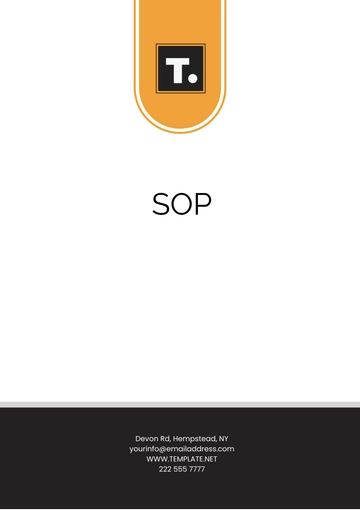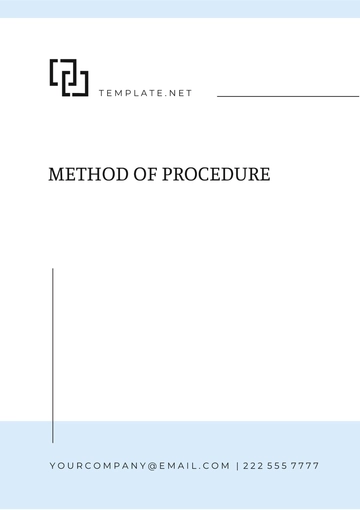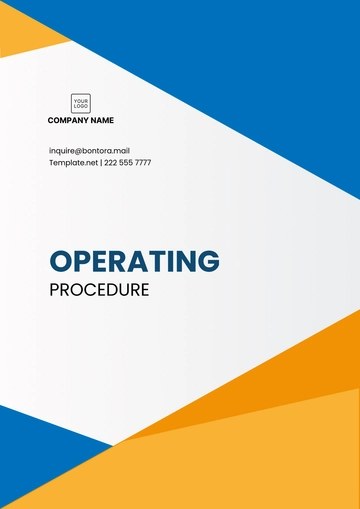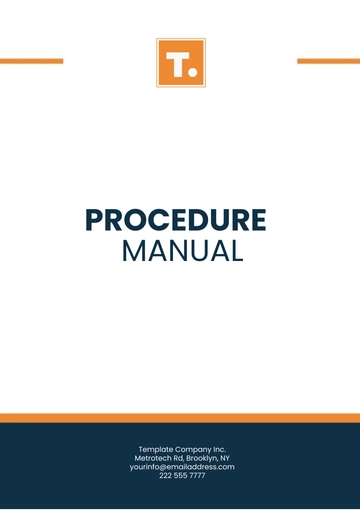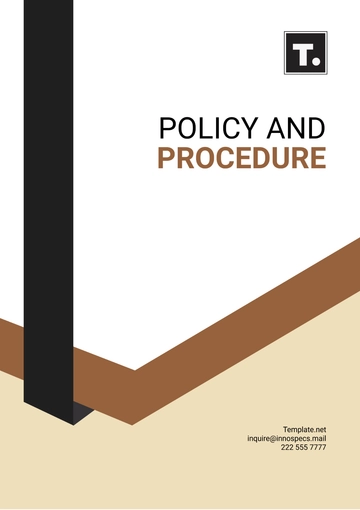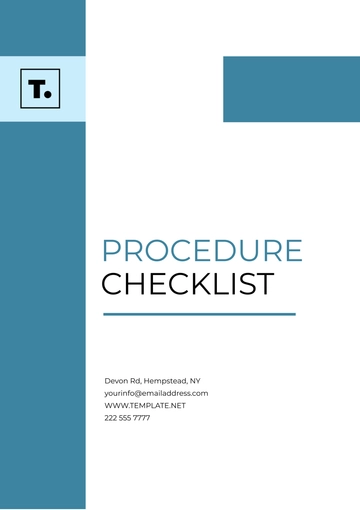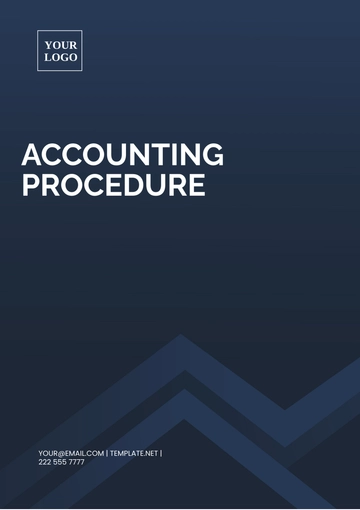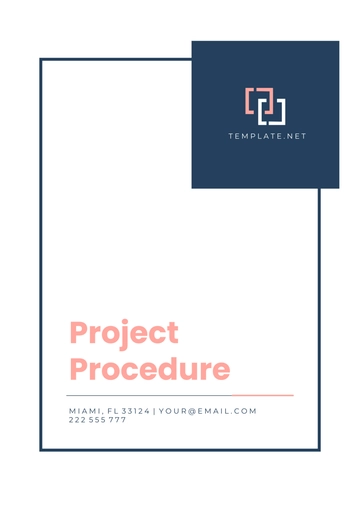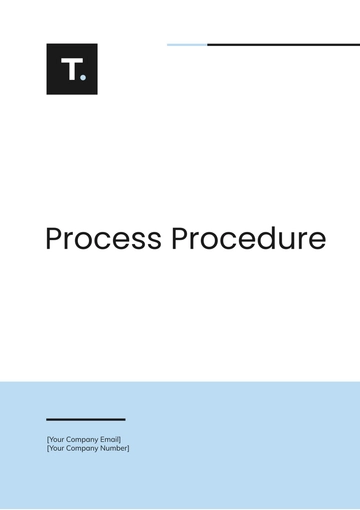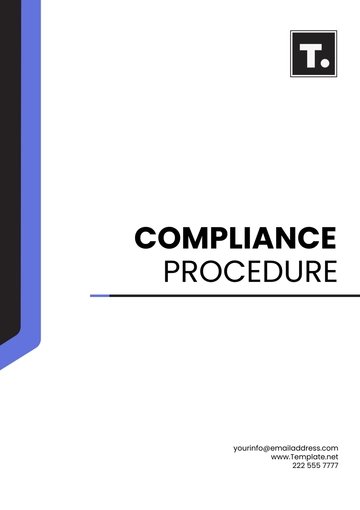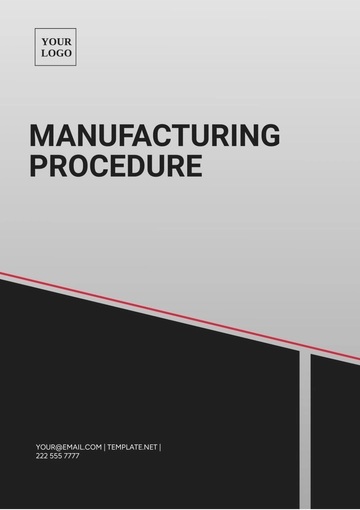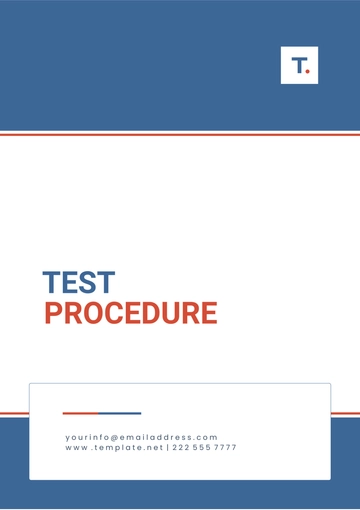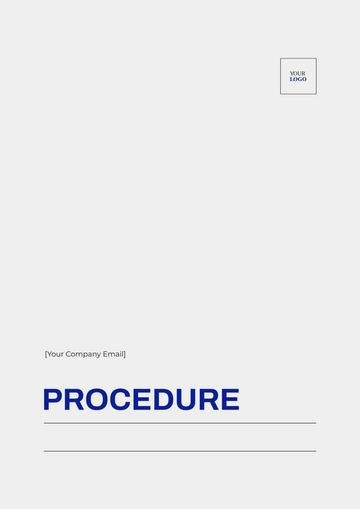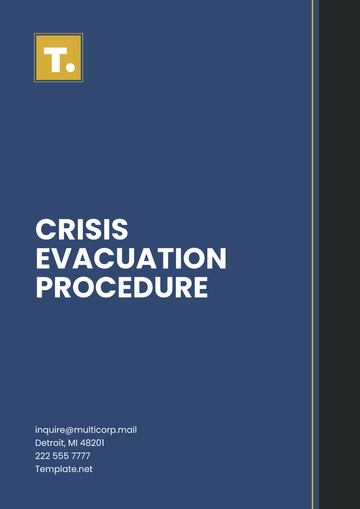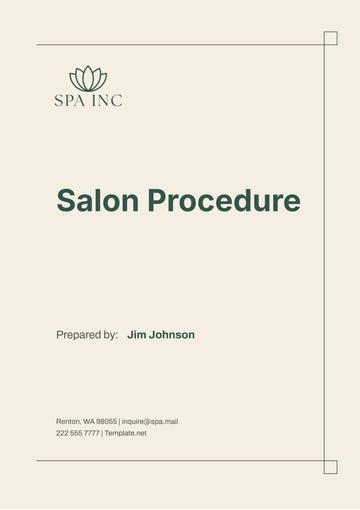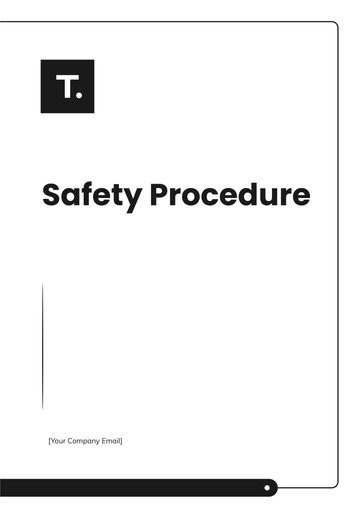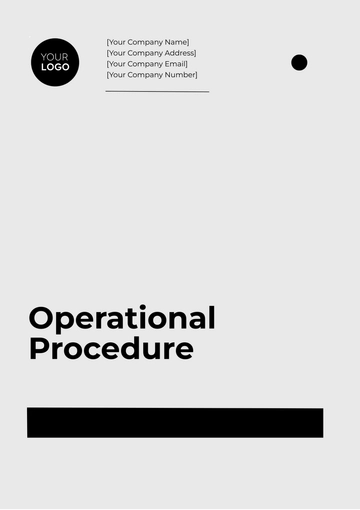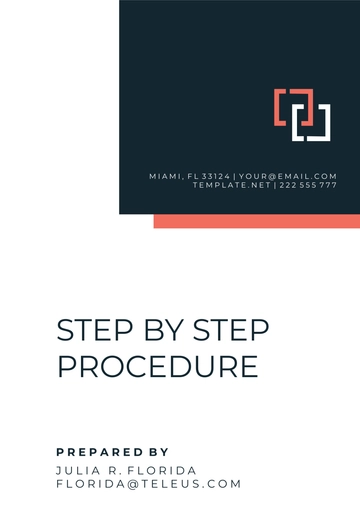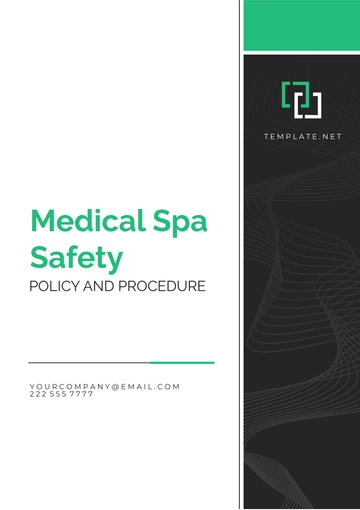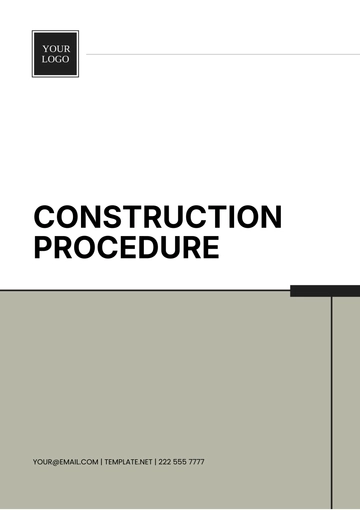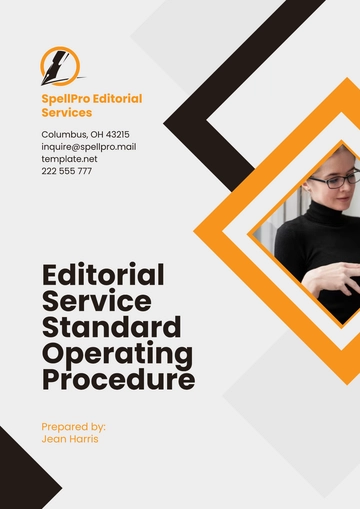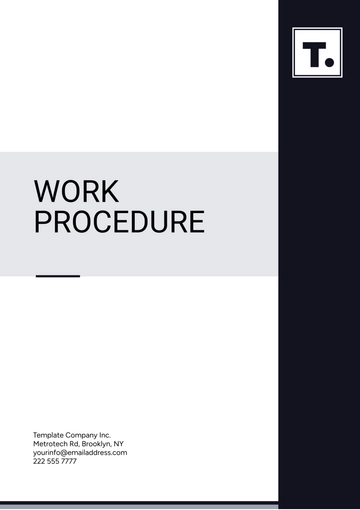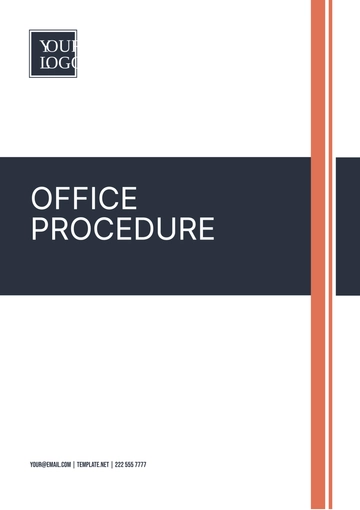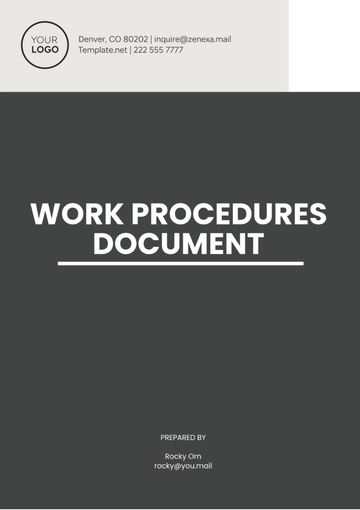Free Hotel Emergency Procedure

I. Introduction
The safety and security of our guests and staff are paramount at [Your Company Name]. This document outlines the comprehensive emergency procedures designed to prepare and guide our team in the event of various emergency situations. Understanding and adhering to these procedures will ensure that we can respond swiftly and effectively to protect everyone involved.
A. Purpose
Clear Guidance: The purpose of this document is to provide clear, actionable steps for handling emergencies. This ensures that all staff members know exactly what to do in a crisis.
Minimize Harm: By following these guidelines, we aim to minimize harm to guests, staff, and property. This proactive approach helps in managing situations efficiently and reducing potential damage.
Compliance: Ensuring compliance with legal and regulatory requirements is another key objective. Adhering to these procedures helps us meet industry standards and maintain our operational integrity.
B. Scope
Applicability: These procedures apply to all staff members, regardless of their role or department within [Your Company Name]. It is essential that every employee is aware of these protocols.
Inclusive Coverage: The document covers a wide range of emergency situations, including natural disasters, medical emergencies, and security threats. This comprehensive scope ensures preparedness for various scenarios.
Mandatory Familiarity: Every employee must be familiar with these procedures and know their specific responsibilities in an emergency. Regular training will reinforce this knowledge.
C. Training and Drills
Regular Training: Regular training sessions will be conducted to ensure all staff members are prepared for potential emergencies. These sessions will cover different types of emergencies and the appropriate responses.
Emergency Drills: Emergency drills will be scheduled periodically to practice the procedures. These drills help in identifying any gaps in the plan and improve overall readiness.
Participation: Participation in these trainings and drills is mandatory for all employees. This ensures that everyone is equally prepared and aware of their roles.
Feedback Mechanism: After each drill, feedback will be collected to evaluate the effectiveness of the procedures. This feedback will be used to make necessary improvements.
D. Responsibilities
Management: Management is responsible for overseeing the implementation of these procedures. They must ensure that all staff members are trained and that drills are conducted regularly.
Security Personnel: Security personnel play a crucial role in managing emergencies. They are responsible for coordinating evacuations, handling security threats, and liaising with emergency services.
Frontline Staff: Frontline staff, including receptionists and housekeeping, must assist guests and ensure their safety. They are often the first point of contact and play a critical role during an emergency.
Maintenance Team: The maintenance team must ensure that all safety equipment is functional and accessible. They also assist in managing building infrastructure during emergencies.
II. Fire Emergencies
A. Initial Response
Activate the Fire Alarm: If you discover a fire, immediately activate the nearest fire alarm pull station. This alerts everyone in the building to the presence of a fire and initiates the evacuation process.
Call Emergency Services: After activating the alarm, call 911 to report the fire. Provide the operator with the hotel's address, the location of the fire, and any other relevant details.
Evacuate the Building: Follow the designated evacuation routes to safely exit the building. Assist guests and ensure that everyone moves calmly and quickly to the nearest exit.
Close Doors Behind You: As you evacuate, close doors to contain the fire and prevent it from spreading. Do not lock doors, as emergency responders may need access.
Do Not Use Elevators: Always use the stairs during a fire evacuation. Elevators can become inoperable or dangerous in the event of a fire.
B. Fire Safety Equipment
Fire Extinguishers: Familiarize yourself with the locations of fire extinguishers throughout the hotel. Only attempt to use an extinguisher if you have been trained and it is safe to do so.
Fire Alarms: Ensure that fire alarms are regularly tested and maintained. Report any malfunctions to maintenance immediately.
Sprinkler Systems: The hotel's sprinkler system is a critical safety feature. Do not obstruct or tamper with sprinkler heads.
Smoke Detectors: Regularly check that smoke detectors are functioning properly. These devices provide early warnings that can save lives.
Emergency Lighting: Ensure that all emergency lighting is operational. This lighting guides guests and staff to exits during an evacuation.
C. Evacuation Procedures
The following table outlines the step-by-step evacuation process:
No. | Step | Description |
|---|---|---|
1 | Activate Alarm | Pull the nearest fire alarm pull station. |
2 | Notify Authorities | Call 911 and provide details about the fire. |
3 | Evacuate | Follow evacuation routes to the nearest exit. |
4 | Assist Guests | Help guests evacuate safely and quickly. |
5 | Close Doors | Close doors behind you to contain the fire. |
6 | Gather at Assembly Point | Proceed to the designated assembly point outside the building. |
Activate Alarm: Activating the alarm is the first crucial step in alerting everyone in the building to the presence of a fire. This immediate action can save lives by providing an early warning and initiating the evacuation process.
Notify Authorities: Notifying emergency services ensures that professional firefighters and medical responders are on their way to handle the situation. Providing accurate information helps them respond more effectively and efficiently.
Evacuate: Evacuating the building promptly is vital to ensure everyone's safety. Knowing and following the designated evacuation routes helps avoid confusion and ensures a swift exit.
Assist Guests: Staff members should assist guests, particularly those with disabilities or special needs, to ensure they can evacuate safely. This demonstrates our commitment to guest safety and care.
Close Doors: Closing doors behind you as you evacuate helps contain the fire and smoke, potentially limiting damage and providing more time for others to evacuate.
Gather at Assembly Point: Gathering at the designated assembly point allows for an accurate headcount and ensures that everyone is accounted for. This step is critical for identifying if anyone is missing or needs assistance.
Effective evacuation procedures are essential for ensuring the safety of guests and staff during a fire emergency. By following these steps, we can minimize confusion and ensure a swift and orderly evacuation. Training and regular drills will help reinforce these procedures and improve overall preparedness.
III. Medical Emergencies
A. Initial Response
Assess the Situation: Quickly assess the situation to determine the nature and severity of the medical emergency. Stay calm and act promptly.
Call Emergency Services: Dial 911 and provide the operator with details of the emergency, including the location and condition of the injured or ill person.
Administer First Aid: If you are trained in first aid, provide assistance until professional help arrives. Use available first aid kits and follow standard procedures.
Stay with the Person: Remain with the person in distress until emergency responders arrive. Offer reassurance and keep them as comfortable as possible.
Prevent Further Harm: Take steps to prevent further injury or harm to the person. This may involve moving them to a safer location or securing any hazards in the area.
B. Medical Equipment
First Aid Kits: Ensure first aid kits are stocked and accessible in key locations throughout the hotel. Regularly check and replenish supplies.
Automated External Defibrillators (AEDs): Know the locations of AEDs and how to use them in the event of a cardiac emergency.
Emergency Numbers: Have a list of emergency contact numbers readily available. This includes local hospitals, emergency services, and poison control.
Medical Training: Encourage staff to undergo basic medical training, including CPR and first aid. This enhances the overall preparedness of the team.
C. Handling Specific Emergencies
The following table outlines steps for handling specific medical emergencies:
No. | Emergency | Step |
|---|---|---|
1 | Cardiac Arrest | Call 911 and Begin CPR |
2 | Choking | Perform Heimlich Maneuver |
3 | Severe Bleeding | Apply Pressure |
4 | Burns | Cool the Area |
5 | Fractures | Immobilize Area |
Cardiac Arrest: In the event of cardiac arrest, immediately call 911 and start CPR if trained. Using an AED as soon as possible increases the chances of survival.
Choking: If someone is choking, perform the Heimlich maneuver to dislodge the obstruction. Continue until the person can breathe or professional help arrives.
Severe Bleeding: For severe bleeding, apply direct pressure to the wound with a clean cloth or bandage. This helps control the bleeding while waiting for medical assistance.
Burns: For burns, cool the affected area by running cool water over it. Cover with a sterile dressing to prevent infection and provide some relief from pain.
Fractures: In the case of fractures, avoid moving the injured person and immobilize the affected area. Apply ice to reduce swelling and wait for professional medical help.
Handling medical emergencies efficiently is crucial for the well-being of guests and staff. Proper training and access to medical equipment can make a significant difference in the outcome of these situations. Regular review and practice of these procedures ensure readiness and confidence in handling medical crises.
IV. Natural Disasters
A. Earthquakes
Drop, Cover, and Hold On: During an earthquake, drop to the ground, take cover under sturdy furniture, and hold on until the shaking stops. This reduces the risk of injury from falling objects.
Stay Indoors: If you are indoors, stay inside and move away from windows and exterior walls. Seek shelter in a safe area until the shaking ceases.
Evacuate if Necessary: After the shaking stops, evaluate the building for damage and decide if evacuation is necessary. Use designated routes and avoid elevators.
Check for Injuries: Assess everyone for injuries and provide first aid where needed. Report serious injuries to emergency responders.
Inspect Utilities: Check for utility damage, such as gas leaks or electrical issues. Shut off utilities if necessary and report issues to maintenance or emergency services.
Communicate with Authorities: Keep in contact with local authorities for updates and instructions. Follow their guidance to ensure safety.
B. Floods
Monitor Weather Alerts: Stay informed about weather conditions and alerts from local authorities. Take preemptive actions based on forecasts.
Move to Higher Ground: If flooding is imminent, move guests and staff to higher floors. Ensure everyone avoids areas prone to flooding.
Protect Utilities: Secure and protect utilities to prevent water damage. Shut off electricity in affected areas to avoid electrical hazards.
Evacuate if Ordered: Follow evacuation orders from authorities and ensure that everyone is accounted for during the evacuation process.
C. Hurricanes and Tornadoes
Stay Indoors: During hurricanes or tornadoes, instruct everyone to stay indoors and away from windows. Use interior rooms or designated storm shelters.
Secure Loose Items: Secure outdoor items that could become projectiles in high winds. Move furniture and equipment away from windows.
Follow Evacuation Orders: If authorities issue evacuation orders, follow them promptly. Use designated evacuation routes and avoid high-risk areas.
Prepare Emergency Kits: Have emergency kits with essentials like food, water, and medical supplies ready for use during and after the storm.
V. Security Threats
A. Active Shooter
Run, Hide, Fight: In an active shooter situation, follow the "Run, Hide, Fight" protocol. Run to safety if possible, hide if escape is not an option, and fight only as a last resort.
Call 911: Contact emergency services as soon as it is safe to do so. Provide detailed information about the shooter's location and actions.
Secure the Area: If hiding, lock doors and turn off lights. Silence mobile devices and remain quiet to avoid detection.
Assist Law Enforcement: When law enforcement arrives, follow their instructions and keep your hands visible. Provide any information that may help them.
B. Bomb Threats
The following table outlines the steps to take in the event of a bomb threat:
No. | Step | Description |
|---|---|---|
1 | Remain Calm | Stay calm and do not panic. |
2 | Gather Information | If receiving the threat, gather as much information as possible from the caller. |
3 | Notify Authorities | Call 911 and inform security and management immediately. |
4 | Evacuate if Advised | Follow instructions from authorities regarding evacuation. |
5 | Search the Area | Assist authorities in searching for any suspicious objects if instructed. |
Stay Calm: Remain calm and do not panic. Keep the caller on the line and gather as much information as possible about the threat.
Call Authorities: Contact 911 immediately after receiving the threat. Provide detailed information about the caller’s voice, background noises, and any specific demands or threats.
Notify Management: Inform hotel management about the threat and follow their guidance on next steps. Management will coordinate with law enforcement.
Evacuate if Advised: Evacuate the building if instructed by authorities. Ensure that guests and staff move quickly and safely to the designated assembly point.
Search the Area: Assist authorities in searching for suspicious objects if instructed to do so. Exercise caution and avoid touching or moving any suspicious items.
C. Handling Suspicious Packages
Do Not Touch: If you encounter a suspicious package, do not touch, move, or open it. Isolate the area and prevent others from approaching.
Notify Authorities: Call 911 and inform security immediately. Provide detailed information about the package's location and appearance.
Evacuate if Necessary: Follow instructions from authorities regarding evacuation and ensure all guests and staff are safe.
VI. Communication During Emergencies
A. Internal Communication
Chain of Command: Follow the established chain of command for internal communication. Ensure all messages are clear and concise.
Emergency Contacts: Maintain an updated list of emergency contacts for all staff members. This list should be accessible to management and security personnel.
B. External Communication
Media Relations: Designate a spokesperson to handle media inquiries. Provide accurate and timely information to the media to manage public perception.
Guest Communication: Inform guests of the situation and provide clear instructions. Use multiple channels such as announcements, in-room notices, and digital communication.
C. Documentation
Incident Reports: Complete detailed incident reports for all emergencies. Include information about the nature of the emergency, response actions taken, and outcomes.
Record Keeping: Maintain records of all emergency drills, training sessions, and actual incidents. Use these records to review and improve procedures.
VII. Recovery and Post-Emergency Procedures
A. Assessing Damage
Inspection: Conduct a thorough inspection of the premises to assess damage and identify hazards. This should be done by trained personnel.
Report Findings: Document and report all findings to management and relevant authorities. This helps in planning repairs and ensuring safety.
B. Cleaning and Restoration
Cleaning: Implement a cleaning protocol to address any contamination or debris resulting from the emergency. Ensure the safety of cleaning personnel.
Restoration: Begin restoration efforts promptly to return the hotel to normal operations. This may involve repairs, replacements, and redecoration.
C. Support for Affected Individuals
Counseling Services: Provide access to counseling services for guests and staff affected by the emergency. Emotional support is crucial for recovery.
Financial Assistance: Offer financial assistance or resources for those who incurred losses or damages. This can help mitigate the impact of the emergency.
VIII. Review and Update
A. Regular Reviews
Annual Review: Conduct an annual review of the emergency procedures to ensure they remain effective and up to date. Incorporate feedback from drills and actual incidents.
Feedback Mechanisms: Implement feedback mechanisms to gather input from staff and guests. Use this information to identify areas for improvement.
B. Updates
Policy Updates: Update the emergency procedures as needed based on changes in regulations, technology, or hotel operations. Communicate updates to all staff.
Training Updates: Ensure that training programs reflect the latest procedures and best practices. Regularly update training materials and sessions.
C. Communication of Changes
Staff Briefings: Hold briefings to inform staff of any changes to emergency procedures. Ensure everyone understands the new protocols.
Guest Notices: Update guest information materials to reflect any changes in emergency procedures. This includes in-room instructions and digital communications.
Regularly reviewing and updating emergency procedures is crucial to maintaining a safe and secure environment. Through continuous improvement and adherence to these guidelines, [Your Company Name] ensures that we are prepared to handle emergencies effectively.
- 100% Customizable, free editor
- Access 1 Million+ Templates, photo’s & graphics
- Download or share as a template
- Click and replace photos, graphics, text, backgrounds
- Resize, crop, AI write & more
- Access advanced editor
Ensure preparedness with our Hotel Emergency Procedure Template from Template.net! This customizable resource provides a structured framework for developing emergency response protocols tailored to your hotel's needs. Utilize the editable features to adapt procedures to various emergency scenarios, and leverage the AI Editor Tool to ensure a tailored procedure immediately!

